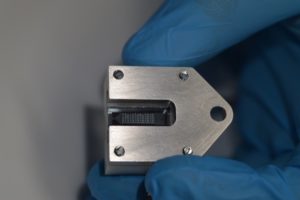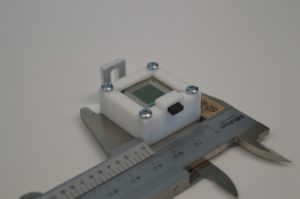The Department of Space Engineering in cooperation with the Else Kooi Laboratory and the Conselho Nacional de Desenvolvimento Científico e Tecnológico (CNPq – Brazil) has been developing micropropulsion systems for use in nano- and pico-satellites (satellites below 10 kg) as an effort to improve and extend the capabilities of these spacecraft. Currently, two different thrusters are under development and are intended to be tested in the first flight of the Delfi-PQ (a satellite of 5 x 5 x 15cm). The payload of the satellite will carry both devices and water will be used as the propellant. Water was selected among many other substances after a thorough study published on the Journal of Heat Transfer that can be found here.
 VLM: The Vaporizing Liquid Microthruster is a chip of 7 x 15mm manufactured with MEMS and silicon technologies. Liquid water enters the chip through the inlet section and goes to a heating chamber used to increase the enthalpy of the propellant from storage levels to the boiling point. A nozzle is then used to accelerate the vapor generated in the boiling to the space generating thrust. It operates with pressures up to 10 bar and contains integrated heaters used to vaporize the water. More details can be found on the recent article published on the journal Sensors and Actuators A: Physical. Click here to access the paper.
VLM: The Vaporizing Liquid Microthruster is a chip of 7 x 15mm manufactured with MEMS and silicon technologies. Liquid water enters the chip through the inlet section and goes to a heating chamber used to increase the enthalpy of the propellant from storage levels to the boiling point. A nozzle is then used to accelerate the vapor generated in the boiling to the space generating thrust. It operates with pressures up to 10 bar and contains integrated heaters used to vaporize the water. More details can be found on the recent article published on the journal Sensors and Actuators A: Physical. Click here to access the paper.
 LPM: The Low Pressure Microresistojet is a relatively new concept that works with rarefied gas dynamics. The vapor generated inside the tank by evaporating or sublimating the water that can be either in a liquid state or a solid state. The gas flows through a series of hot microchannels in a MEMS chip of 20mm x 20mm where it is heated and expanded at high Knudsen numbers to high exhaust velocities producing thrust. A recent article, published on the Journal of Micromechanics and Microengineering, can be found here with a more detailed description of the thruster.
LPM: The Low Pressure Microresistojet is a relatively new concept that works with rarefied gas dynamics. The vapor generated inside the tank by evaporating or sublimating the water that can be either in a liquid state or a solid state. The gas flows through a series of hot microchannels in a MEMS chip of 20mm x 20mm where it is heated and expanded at high Knudsen numbers to high exhaust velocities producing thrust. A recent article, published on the Journal of Micromechanics and Microengineering, can be found here with a more detailed description of the thruster.
The payload for the Delfi-PQ currently under development will carry both thrusters that are designed to share the same propellant tank in order to optimize space.
Contact information:
Daduí Cordeiro Guerrieri – d.cordeiroguerrieri@tudelft.nl
Marsil de Athayde Costa e Silva – m.deathaydecostaesilva@tudelft.nl
Angelo Cervone – a.cervone@tudelft.nl